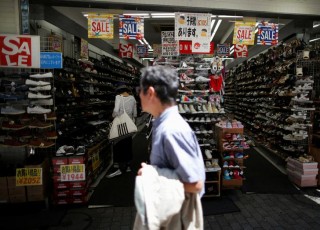Loading
Search
▼ Japan Inflation Ticks Up As Oil Rises But BOJ Target Remains Elusive
- Category:Other
TOKYO - Japan’s annual core consumer inflation ticked up in September but remained at half the pace of the central bank’s elusive 2 percent target, underscoring the challenge of meeting the price goal as escalating trade frictions cloud the economic outlook.
While the rate of increase was the fastest in seven months, the gain was due mostly to higher oil costs with most other items rising only slightly, government data showed on Friday.
“We’re not seeing inflationary pressure build up. Private spending needs to increase more for core consumer inflation to accelerate beyond 1 percent,” said Takeshi Minami, chief economist at Norinchukin Research Institute. “Inflation will probably stagnate around current levels for some time.”
The nationwide core consumer price index (CPI), which strips away the effect of volatile fresh food costs, rose 1.0 percent in September from a year earlier, matching a median market forecast and ticking up from 0.9 percent in August.
The so-called core-core CPI, a more closely watched gauge the Bank of Japan uses that excludes the effect of both fresh food and energy costs, stood at 0.4 percent in September, in line with the previous month.
The inflation data will be among factors the central bank examines at its rate review on Oct. 30-31, when it conducts a quarterly review of its growth and price projections.
BOJ Governor Haruhiko Kuroda on Thursday offered a slightly more upbeat view on prices than three months ago, saying that core consumer inflation was “moving around 1 percent.”
Rising energy costs may give the BOJ justification to slightly revise up its inflation forecasts, though the boost may be moderated by uncertainty over the fallout from escalating trade frictions, analysts say.
In a quarterly report scrutinizing Japan’s regional economies, the BOJ cut its assessment for two regions and warned that companies were becoming increasingly worried about the hit from the simmering Sino-U.S. trade frictions.
Under current projections made in July, the BOJ expects core consumer inflation to hit 1.1 percent in the year ending in March 2019, and accelerate to 1.5 percent the following year.
Stubbornly soft inflation has dashed the BOJ’s hopes that solid economic growth will translate into higher prices, and could delay the central bank’s exit from ultra-loose policy.
Japan’s economy rebounded in the second quarter from a contraction in the first three months of this year thanks to robust business spending.
But escalating trade frictions and a series of natural disasters that disrupted supply chains cloud the outlook for the export-reliant economy, with some analysts projecting a slight contraction in the July-September quarter.
Uncertainty over the economic outlook adds to challenges for the BOJ, which has struggled to fire up wages and prices despite years of heavy money printing.
© (c) Copyright Thomson Reuters 2018.
While the rate of increase was the fastest in seven months, the gain was due mostly to higher oil costs with most other items rising only slightly, government data showed on Friday.
“We’re not seeing inflationary pressure build up. Private spending needs to increase more for core consumer inflation to accelerate beyond 1 percent,” said Takeshi Minami, chief economist at Norinchukin Research Institute. “Inflation will probably stagnate around current levels for some time.”
The nationwide core consumer price index (CPI), which strips away the effect of volatile fresh food costs, rose 1.0 percent in September from a year earlier, matching a median market forecast and ticking up from 0.9 percent in August.
The so-called core-core CPI, a more closely watched gauge the Bank of Japan uses that excludes the effect of both fresh food and energy costs, stood at 0.4 percent in September, in line with the previous month.
The inflation data will be among factors the central bank examines at its rate review on Oct. 30-31, when it conducts a quarterly review of its growth and price projections.
BOJ Governor Haruhiko Kuroda on Thursday offered a slightly more upbeat view on prices than three months ago, saying that core consumer inflation was “moving around 1 percent.”
Rising energy costs may give the BOJ justification to slightly revise up its inflation forecasts, though the boost may be moderated by uncertainty over the fallout from escalating trade frictions, analysts say.
In a quarterly report scrutinizing Japan’s regional economies, the BOJ cut its assessment for two regions and warned that companies were becoming increasingly worried about the hit from the simmering Sino-U.S. trade frictions.
Under current projections made in July, the BOJ expects core consumer inflation to hit 1.1 percent in the year ending in March 2019, and accelerate to 1.5 percent the following year.
Stubbornly soft inflation has dashed the BOJ’s hopes that solid economic growth will translate into higher prices, and could delay the central bank’s exit from ultra-loose policy.
Japan’s economy rebounded in the second quarter from a contraction in the first three months of this year thanks to robust business spending.
But escalating trade frictions and a series of natural disasters that disrupted supply chains cloud the outlook for the export-reliant economy, with some analysts projecting a slight contraction in the July-September quarter.
Uncertainty over the economic outlook adds to challenges for the BOJ, which has struggled to fire up wages and prices despite years of heavy money printing.
© (c) Copyright Thomson Reuters 2018.
- October 19, 2018
- Comment (0)
- Trackback(0)


